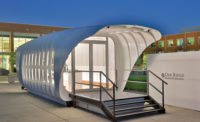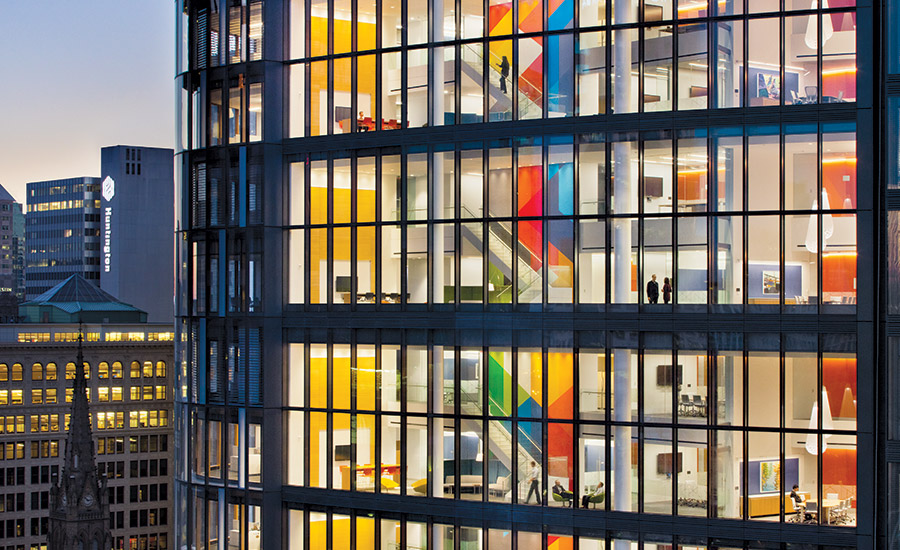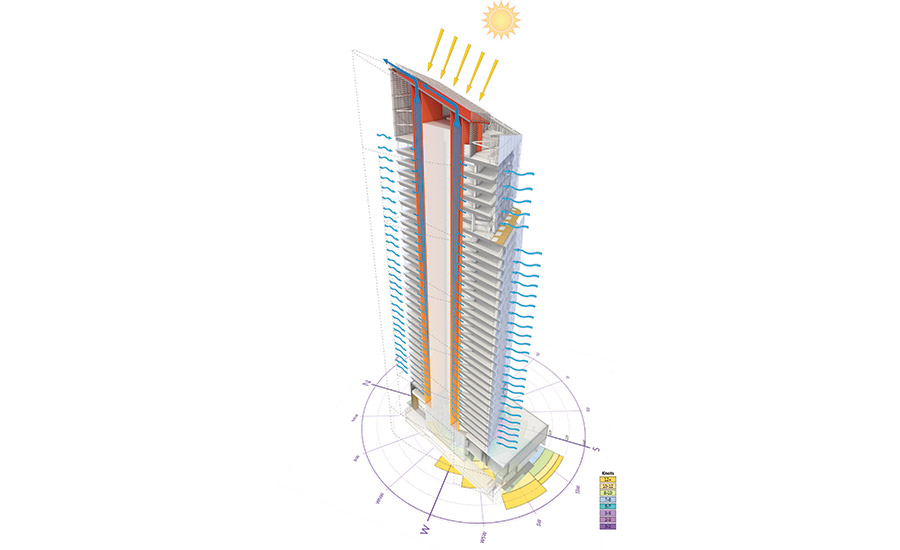Continuing Education: Natural Ventilation and Office Towers
Poppers and Floppers and Porches, Oh, My! Gensler creates a building that breathes for a client with a deep commitment to sustainability.

The building has several types of facade systems that contribute to its unusual climate control strategy, including a west-facing, shallow double skin.
Photo © Connie Zhou

The tower is rotated off the street grid so that the slanted cap of its solar chimney faces south and captures the maximum amount of thermal energy.
Photo © Connie Zhou

The facade system includes wood-framed sliding glass doors that occupants can operate in order to stand on the “porch” within the double-skin cavity.
Photo © Connie Zhou

When temperature and humidity conditions are right, tall and narrow “poppers” on the exterior of the north and south facades, and sill-level vents on the interior open, letting fresh air in.
Photo © Connie Zhou

The solar chimney comprises two shafts in the building’s core. These extend from the lowest office floor to the crown, where they are joined by a 5,000-square-foot chamber topped with a concrete slab and a glass roof.
Diagram © Gensler

The tower provides several types of environments as alternatives to employees’ individual cubicles. These include double-story “neighborhoods” for every two office floors and a five-story-tall sky garden on the tower’s 28th floor. Both are intended as places for breaks and small, informal meetings.
Photo © Connie Zhou

The tower provides several types of environments as alternatives to employees’ individual cubicles. These include double-story “neighborhoods” for every two office floors and a five-story-tall sky garden on the tower’s 28th floor. Both are intended as places for breaks and small, informal meetings.
Photo © Connie Zhou

Image courtesy Gensler








Gensler’s new 545-foot-tall Tower at PNC Plaza is hardly the tallest skyscraper in downtown Pittsburgh. That distinction belongs to Harrison, Abramovits & Abbes’s 841-foot-tall U.S. Steel Tower, built more than four decades ago. But, even so, PNC can make some large claims for its new headquarters. The financial services corporation boasts that the $400 million project, which officially opened on October 1, is the greenest office tower—not just in the city, but the world.
The 33-story building may not be tall and trim, but its curved and cranked shaft and its angled cap are signs of its preoccupation with sustainability. And its green aspirations didn’t just come out of the blue—the company has a long history with sustainable building. Its real-estate portfolio includes a 650,000-square-foot operations center in Pittsburgh, which held the title of being the largest LEED building for several years after its certification in 2000. PNC was also instrumental in the creation of the LEED volume program, certifying its first 12 bank branches in 2006. Its Washington, D.C., headquarters, completed in 2010, was one of the first Platinum buildings in the nation’s capital. The company now claims more than 250 LEED-certified buildings worldwide.
But for this project, which Gary Saulson, PNC’s director of corporate real estate, refers to as “beyond Platinum,” the LEED plaque was not the ultimate objective. “Certification was more of a confirmation rather than the goal,” says the project’s sustainability consultant, Tom Paladino, CEO of Paladino and Company. Here, PNC employed a more expansive, and less quantifiable, definition of “green” that included social aims such as workplace innovation and community building. “This is not a typical paradigm,” says the Gensler principal in charge of the tower, Doug Gensler. “We needed to rethink the current way of measuring building performance.”
Of course, this broader definition of greenness and a more conventional one based on resource conservation are not mutually exclusive. The tower is projected to use about half the energy of a more typical office building that complies with the 2007 version of the ASHRAE 90.1 energy standard.
This anticipated performance is the result of a host of tightly integrated sustainable strategies instead of one particular technology. But the single feature that may make the biggest contribution is the building’s ability to “breathe.” For a considerable portion of the year, the Tower at PNC Plaza will rely on operable windows and flaps in its sophisticated glass skin to bring in fresh air, rather than on mechanical ventilation. This move alone should produce significant savings, since the operation of HVAC systems is responsible for more than a third of overall energy consumption in a typical tall office building, according to the Council on Tall Buildings and Urban Habitat.
Before the 1950s, skyscrapers were constructed without mechanical ventilation or cooling. But given current comfort expectations and Pittsburgh’s climate, eliminating active climate-control systems in PNC’s new tower was impractical. However, analysis by BuroHappold, the project’s structural and mechanical engineer, showed that temperature and humidity conditions would still allow natural ventilation for about 42 percent of working hours. The project team felt this figure was substantial enough to warrant a hybrid approach combining natural ventilation with mechanical systems such as energy recovery air handlers, high-efficiency boilers and chillers, and active chilled beams.
A solar chimney is literally at the center of the innovative fresh-air strategy. It comprises two shafts in the tower’s core that extend from the lowest office floor to its crown, where they are joined by a 5,000-square-foot chamber topped with a glass roof. This cap, sloped and angled toward the south, includes a concrete slab under the glass that is ribbed and painted black in order to trap solar radiation. The configuration capitalizes on the stack effect, which creates a pressure draw, pulling fresh air through the operable facade, across open office areas, and finally vents it through the solar chimney. During cooler weather, the chamber can also preheat outdoor air before distribution to the rest of the tower.
The envelope plays a key role in this climate-control scheme. The building has several double-skin types, but the primary one, cladding the north and south elevations, is made up of laminated glass on the exterior, an insulated glazing unit (IGU) on the interior, with a 30-inches-deep cavity in between. The IGU incorporates a coating to help retain heat during the winter, but because the cavity includes automated shades, no solar-controlling, low-E coating was necessary. The resulting assembly is about 87 percent transparent.
When humidity, temperature, and air quality conditions are ideal—primarily during the spring and fall—the building management system (BMS) opens poppers (tall and narrow windows on the outward-facing skin) and floppers (vents at sill level on the inner skin) to let fresh air flow into the workspaces. According to its designers, the tower is the first in North America to employ a double skin in combination with a solar chimney to passively bring in fresh air.
This facade has several additional modes of operation. For example, during the summer, the poppers can be opened, and the floppers left closed in order to cool the cavity and help maintain comfortable indoor temperatures. In the winter, both poppers and floppers can be kept closed, allowing the air between the two skins to heat up and act as a thermal buffer, performing in much the same way as winter clothing. “It’s like wearing a fleece with a shell over it,” explains Benedict Tranel, a principal at Gensler and the project’s technical director. “The inner facade is insulating, while the outer one keeps the water out.”
Although the double skin is almost entirely automated, occupants are given some individual control. By turning on a green light mounted on the ceiling of the office area, the BMS lets employees know when they can open wood-framed sliding glass doors that are part of the interior-facing skin without interfering with the active climate-control systems. They can slide these doors open just a crack, or open them wide enough to step out onto what us referred to as a “porch”—a metal louvered floor that runs in the cavity. By including this element, the design team hopes occupants will have a more direct connection to the city and the outdoors than they would have sitting at their desks.
Getting a grasp on how the natural ventilation system would perform required extensive energy modeling as well as computational fluid dynamics (CFD) studies. The engineers combined these analyses with physical models, building an approximately 8-foot-by-8-foot mockup of the solar chimney’s cap during schematic design and mounting it on the roof of another PNC building nearby. The data gleaned from this mockup, which was outfitted with sensors tracking surface and air temperatures, and monitored for more than a year, helped the team understand how much thermal energy the chimney’s concrete could store and what weather extremes it would experience in each season. It also helped validate the virtual analyses. “We found that the mockup was behaving in a similar way to our computer models and this gave us confidence in our simulation data,” says Denzil Gallagher, a BuroHappold principal.
Team members built a second mockup during the construction-document phase of the project at a Pittsburgh industrial park. This time, they built a 1,200-square-foot portion of the southwestern corner of a typical office floor. They used it over the next 2½ years to review and tweak a wide variety of building components and systems, including the double-skin facades and the integration of the natural ventilation strategy with the active HVAC equipment. The designers evaluated options for the automated shades, considering factors like what amount of perforation would provide the right balance of glare reduction, daylight penetration, and visibility. They also tested elements such as the double skin’s manually operated wood-framed doors—which at 10 feet tall and 5 feet wide weigh more than 600 pounds—to make sure they were easy enough for employees to slide open. In addition, they studied how best to configure the office furniture so as not to impede the flow of outdoor air coming in through the low-level floppers, determining that cubicle partitions shouldn’t extend to the floor.
As part of satisfying PNC’s workplace innovation aims, the project team created a variety of workspaces within the building, so employees need not stay in their individual cubicles. Each of these spaces has its own climate-control strategy. For example, every two office floors share a living room–like, double-story space intended for informal meetings or collaborative tasks. These west-facing “neighborhoods” include different kinds of upholstered seating around small tables and are enclosed behind a shallow dual-glass skin with a cavity that is only 8 inches wide. This skinnier facade does not have poppers or floppers, but it incorporates automated shades and is continuously ventilated from the exterior to prevent heat gain from the late-day sun.
Near the top of the building, above the stacked neighborhoods, a sky garden offers yet another alternative for employees. In this five-story-tall atrium, which sits behind a cable-net wall of laminated low-iron glass, occupants can work against the backdrop of the city’s skyline, its rivers, and famous bridges. Although facility managers have the ability to control conditions for special events like parties or receptions, in general the temperature here is allowed to fluctuate, tempered only by its radiant floor. The space, which includes native plantings that change with the seasons, is intended to provide a setting that is similar to the outdoors, but sheltered from the wind and rain.
PNC also considered community-building efforts as integral to the project’s mission. These run the gamut from job-creation initiatives, such as persuading the curtain wall contractor to set up a local assembly factory, to the skin’s aesthetic expression, which, because of its highly transparent double-skin system, allows a strong visual connection between inside and out. “PNC didn’t want a fortress,” says Gensler.
One of the more notable demonstrations of the company’s commitment to the city is the skyscraper’s water-recycling system. It will reclaim and treat stormwater, as well as gray- and blackwater, using it for toilet flushing, irrigation, and as makeup water in the cooling tower. Combined with low-flow fixtures, this strategy will reduce potable water consumption by an estimated 77 percent. But more important for the city and its infrastructure, that means diverting the majority of the building’s wastewater from Pittsburgh’s overburdened combined sewer system.
Even though the building is complete, and over half of its eventual 2,000 occupants have moved in, it will take time to understand how well it is actually functioning. Paladino will be working with the commissioning agent and owner to conduct measurement and calibration over the tower’s first four seasons and track performance. But it will probably be more difficult, yet no less important, to understand how well employees take to their new home. Will they have serendipitous meetings with their colleagues in the double-story neighborhoods? Will they eat lunch in the sky garden? Will they take advantage of the porch within the double skin? “The tower will be successful,” says Gensler, “when users embrace their role.”
|
Continuing Education
 To earn one AIA learning unit (LU), including one hour of health, safety, and welfare (HSW) credit, read “Poppers and Floppers and Porches, Oh, My!,” review the supplemental material at architecturalrecord.com, and complete the online test. Upon passing the test, you will receive a certificate of completion, and your credit will be automatically reported to the AIA. Additional information regarding credit-reporting and continuing-education requirements can be found online at continuingeducation.bnpmedia.com. To earn one AIA learning unit (LU), including one hour of health, safety, and welfare (HSW) credit, read “Poppers and Floppers and Porches, Oh, My!,” review the supplemental material at architecturalrecord.com, and complete the online test. Upon passing the test, you will receive a certificate of completion, and your credit will be automatically reported to the AIA. Additional information regarding credit-reporting and continuing-education requirements can be found online at continuingeducation.bnpmedia.com.Supplemental Material Natural Ventilation in High-Rise Office Buildings (preface and historical overview) Council on Tall Buildings and Urban Habitat Engineering the Tower at PNC Plaza By BuroHappold
Learning Objectives
1 Explain the integration of natural and mechanical ventilation at the Tower at PNC Plaza.
2 Explain how the tower’s climate-control system operates in different seasons and different conditions.
3 Describe the design and simulation process that helped refine this climate-control scheme.
4 Outline the history of natural ventilation in office towers.
AIA/CES Course #K1512A
For CEU credit, read “Poppers and Floppers and Porches, Oh, My!” and take the quiz at continuingeducation.bnpmedia.com, or use our Architectural Record Continuing Education app, available in the iTunes store.
|
People
Architect:
Personnel in architect's firm who should receive special credit:
Interiors:
*registered architect
Engineers:
Consultants:
General contractor:
Photographer: Client: PNC Financial Services Group Size: 800,000 square feet Project Cost: $400 million Completion date: October 2015 |
Products
Structural system
Exterior cladding
Roofing
Glazing
Doors
Hardware
Interior finishes
Furnishings
Lighting
Conveyance
Plumbing
Energy
Other unique products that contribute to sustainability:
Other components or special equipment that made a significant contribution to this project: |












